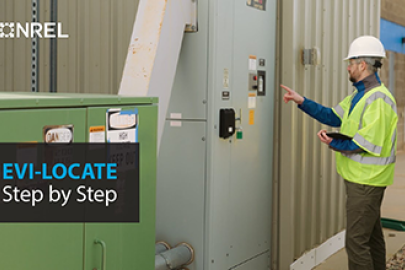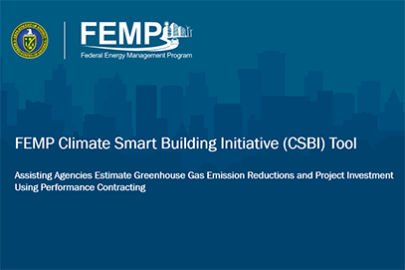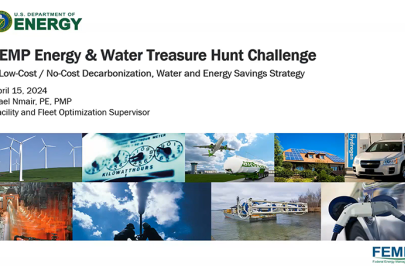This webinar recording walks through the best practices for submitting an AFFECT application.
Federal Energy Management Program
June 10, 2024This Federal Energy Management Program webinar walks through the best practices for submitting an Assisting Federal Facilities with Energy Conservation Technologies (AFFECT) application. View examples of lessons learned from submitted applications, projects prime for a funding boost, and how to ensure your application makes the grade.
Visit the Clean Energy Infrastructure Funding Opportunity eXCHANGE for access to more information about AFFECT and presentation slides.
SOUDEH MOTAMEDI: Hello, and welcome to Applying for AFFECT Funding, Best Practices and Lessons Learned. I'm Soudeh Motamedi, the program manager for this specific grant program as managed by the Federal Energy Management Program, or as known by many as FEMP. And I will be your host today. Please note, this webinar is being recorded and will be posted on the US Department of Energy's Clean Energy Infrastructure Funding Opportunity Exchange page, or the shorter version, which is S3 Exchange.
During this webinar, I will be providing an overview of relevant federal requirements and goals, best practices and lessons learned, provide some examples of strong and weak application responses, and finally, we'll share some helpful resources. DOEs authority for AFFECT, a grant program specifically for federal agencies derives from the Energy Policy Act of 1992 as codified in 42 US code, section 8256b, with this stated purpose of providing competitive grants to agencies to meeting the energy and water conservation requirements in section 543 of the National Energy Conservation Policy Act as amended. The code also lays out the determining factors for the selection, which all AFFECT FACs must adhere to.
These factors consist of the cost effectiveness of the project, amount of cost savings anticipated, amount of funding committed by the applicant, extent to which financing from other non-federal sources is leveraged, and other factors as determined by the Secretary. FEMP has been administrating AFFECT since 2014. Funding for the grant is appropriated and varies each year.
In 2022, the grant program received an unprecedented $250 million via the bipartisan infrastructure law. Heard authorizing statute—all AFFECT FACs support agencies in meeting their energy and water conservation requirements as set in 42 US code section 8253. Some of the goals and requirements of this section are metering for utility use, reducing energy use intensity and water use intensity, benchmarking buildings and improving operations, evaluating identifying and implementing measures to ensure performance of your buildings, and of course there is investing in implementing the measures.
In addition to the authorities that set the parameters for AFFECT FACs, AFFECT also supports other agency requirements and goals as set by the Energy Act of 2020 Executive Order 14057 catalyzing clean energy industries and jobs through federal sustainability, along with Executive Order 14008 tackling the climate crisis at home and abroad. These include climate smart buildings initiatives and federal buildings performance standards as well.
I'm sure you've seen this slide many times, so I won't go into the details of it, but I did want to highlight the fact that AFFECT can support these other requirements and goals. AFFECT also supports your energy and water saving measures that help with electrifying your facilities, decarbonizing your operation, enhancing site resilience and security, measuring and automating energy systems, installing renewable and carbon pollution free electricity, and many more items.
AFFECT supports a variety of technologies, such as standard building operation upgrades that consist of windows and HVACs and lighting, to larger system upgrades that electrify your campus or have set up microgrids where you replace your boilers and chillers. You can install clean and renewable energy systems such as solar and geothermal. As you can see, this is a selection of technologies that were selected under phase one of the AFFECT BIL, lots of different technologies.
So the point of these slides has been to go, you can do a lot with AFFECT. It can support a lot of things. But how do you bring it all together?
So let me get into some of the best practices and some of the lessons we've learned. One thing to know early on is that you should understand the AFFECT grant cycle so to assess how it fits with your project cycle, and then reviewing the deliverables in each of the FAQs to see if you can meet them or not because that will help you have a better application. Typically, the application period is going to be about three months, evaluation and selection is about six months, and then there's a negotiation period where we discuss timelines, deliverables, and things of that—that's about two to three months.
And then the award performance and funding disbursement vary and depend on your project, and there's some flexibility in discussions on that. But it's good to know this so that you know if applying makes sense or not. And then one last thing—I will put a plug in—is that there is going to be ongoing reporting after the funds have been distributed and the project implemented. And we need to know what the outcomes are.
One thing to keep in mind is that being selected for award does not guarantee funding disbursement because it depends on that award performance. So be sure that when you do put in an application, you can meet those requirements. And each FAC will differ a little bit, so you should look at those. Some advice, repeating it again, please closely read the grant announcement, the posted questions and answers for the grant.
Consider taking a look at past projects that were selected for award for examples. If selected for award, make sure you have accounts for the required systems and maintain access to ensure timely funding release. Some of these key systems for AFFECT are EERE's project management center, this is what we use for NEPA requirements, sam.gov, and FedConnect.
You can leverage FEMP's technical assistance, services and training, but keep in mind, AFFECT is a competitive process, and as such, personnel are prohibited from assisting with the application development and communicating in writing or otherwise with agencies regarding the FAC, specifically, through discussions and calls. It has to be via email. There is an established questions and answers process.
Build a strong AFFECT team by engaging all key projects. Include your facility manager, project or program champion, your contracting officer or procurement team, legal, environmental and NEPA officers and other partners. So make sure you have a strong team. Again, leverage AFFECT to boost your project impact by meeting several goals and requirements, such as the Energy Act of 2020 requirement to fund 50% of your projects with performance contracts.
Ensure your project is comprehensive and maximizing impact of the grant while supporting your sustainability, your climate, your electrification and resilience goals. And then we've got some other kind of stats here. There's an investment tax credit that you could leverage through the energy sales agreement if it fits your project, and then obviously, the benefits of operation and maintenance savings.
Reinforcing that combined with performance contracts, AFFECT can increase the impact of your project by expanding the scope of your project, but also the benefits of it. So this is a study that our ESPC had done and what they're so far estimating that it can result in AFFECT leading to a one million and AFFECT could also result in one million in savings. But there's lots of different ways of leveraging affect.
Expanding your project is great, but you have to be realistic. Be sure to consider your supply chain issues, interest rates, utility rates. Look at the project from a campus or site perspective. Go broader than a building to make sure the impact is helpful across and it can be replicated at scalable, and it makes sense.
That's the other part of it, it has to make sense for what you're trying to accomplish. Recommending energy and conservation first, then resilience and decarbonization kind of as a best practice. And then you want to show how the AFFECT grant funding improves your baseline project.
That's the key, you should have a baseline project that the AFFECT grant is going to help. This could be increasing the ECM numbers. It could be increasing the types of it, scope of the project, more building sites. It'll vary by your project and your requirements and what you're trying to accomplish.
A few other lessons that we've learned and advice is make sure all the information requested in the application forms are addressed. Double check the values in the forms, the applications, a project builder template, the summary slides for consistency and accuracy. This is extremely important. When it's not consistent, it is difficult to evaluate your application.
Now for some examples of strong and weak application responses to just give you a sense. I will not read the actual responses, but I will give you a highlight of what made it strong and what made it weak. Again, this will be posted online. You can read them later on.
In general, what we've kind of teased out is common themes. For weak application is they don't provide enough information with not enough details. There's no baseline project in some cases. Or it's not being expanded and there's enough full story of why you need the grant.
There are no descriptions of what the ECMs are and which ones are being impacted and helped by AFFECT. Whether it's new, it's the size being changed or capacity, that information is not there. Sometimes the responses are copy and paste of requirements without making the connection of how the project will help the applicant towards these requirements.
If you have incomplete or blank tables and text boxes. The project depends solely on the grant. The key is you have to leverage the grant. So when it's only on the grant, it's not the greatest application. Its inconsistent and questionable estimates, not using the right project builder templates or they're incomplete. There is no discussion or recognition of possible risks and how they may be addressed to ensure the success of the project.
On the other hand, a strong application response provides adequate details, responds to the questions in the forms fully, completes all tables and text boxes in the application form, recognizes possible risks and outlines possible solutions to mitigate, leverages other or multiple funding sources to maximize the impact of the project and the grant, provides value for both the baseline project and the adjusted or expanded project with a grant, includes a complete list of ECMs for both the baseline and the grant project by type, count, size, capacity in a project builder, uses a consistent data and story in the application, the summary slides and the project template, used a correct E project template, completed appropriate fields. Finally, they make sure everything is correct and they are using the most updated application form.
OK, this is considered a weak response. This is considered a weak response because it doesn't provide a great project description and doesn't illustrate how affect would change the project. While this is a strong response. It's a bit longer. It addresses all the questions by explaining the impact of the grant on the project and providing key details.
As you can see, longer. This is weak because it's blank. You don't have to provide a lot of information. Just highlighting where the grant is going to have the most impact is important. This is considered a strong response.
Similar kind of example, but in this case there isn't a project without the grant. Well here, you can clearly see there's a project without the grant, and then with the grant, and you can see certain numbers changed and improved. Not all—that's OK, but you can see the impact of the grant.
No response was provided. We had a response here. And it addresses the response appropriately. Addressing the question that's being asked, talking about your operation and maintenance. So make sure you address the question in the form.
This isn't bad. They filled it out. But there's a few things that was left out. And there's nothing committed by the agency or somebody in some other resource. And the cost leverage wasn't calculated.
Whereas here, you can see a mix of different types of funding sources that are being leveraged and it's as complete as it makes sense for the project. This is considered a weak response. I don't know and I cannot tell what and how the project will help move the needle towards these goals.
While on this case, I know exactly which goal they're moving towards, and then how their project will impact and move the needle towards that goal. This isn't too bad of a response, but it's considered weak because it's only solely dependent on the grant. It addresses the risk, but not too much.
It does help with the mitigation as well, too. So it's not too bad, but it could have been better. And then we have a slightly stronger response. It's showing how the grant will be leveraging other funding.
It's demonstrating how the project's going to be scalable. It does miss the risk aspect and what they may be and how they're going to mitigate it. So it's a balance between how you respond. Please try to respond as best as you can, as complete as you can, and make sure it's consistent and accurate throughout all the documents. That should be a key takeaway.
And some resources—OK. So I didn't read the responses. These will be posted. I wanted to highlight some of the examples and why they were considered either weak or strong. It's just a select few to give you a sense. But a lot of things that I would say need to also do is make sure you look at the resources that we've posted.
Make sure you're familiar with the federal agency call. If you have questions, go to the questions and answers. They're all available on Exchange. Search for it. There's a lot of questions and answers that have already been addressed during phase one, and you can see the answers there.
The questions may be a little bit different, but the answers will probably be the same. If you can't find it, send an email to the the [email protected]. Make sure you're using the latest application forms.
Those are important to use because they do get updated. They have been changed, so make sure you use that, including the summary slide tables. We have had a lot of training sessions. All the recordings have been posted, just like this one will be posted as well.
Go to those. Check them out. All of them are available to you to look at and use as a resource. If you have issues with Exchange, unfortunately, our team can't help you out as much. But the infrastructure exchange team can, and their email is infrastructureex [email protected].
So reach out to them. They do reach out to us sometimes when it seems like that's not something they can help out with or not. Some other resources that I recommend taking a look at just to become familiar with is look at the EERE PMC. There's sample guidance on there and questions and forms that you can take a look at to see the types of questions we ask for.
There's guidance on how to set up on FedConnect and IPAC. I do note IPAC on there because eventually funds will go through there. So it's good to make sure you have the right accounts and if unsure, here are some resources to make sure that you're set up properly.
And then we have some additional resources. If you aren't familiar with performance contracts, FEMP has a lot of resources on different types of performance contracts, energy savings contracts, ESPC ENABLE, ESPC ESA. We have the UESC, which is Utility Energy Service Contracts, Enhanced Use Leases, how to do life cycle costing analysis—there's lots of documents on that as well. But these will be available to you to take a look at.
Keep in mind there's a phase three and there will be other phases for AFFECT. These are resources that you can use any time for these future grants. And with that, I know it went quickly, but hopefully lots of great information and useful information that you can use as you pull your applications together.
I will have a couple of reminders. AFFECT is a competitive process so FEMP personnel are prohibited from communicating and writing or otherwise with agencies regarding the FAC, except through the established questions and answers process. Please email the AFFECT team your questions, which is [email protected].
If you're planning to apply for AFFECT, keep in mind that the training sessions and presentations provide overarching information and summaries only. Applicants are strongly advised to read the full open FAC closely for full details. This will vary by each FAC once it's posted. And then with that, I will say thank you for your time today and I look forward to seeing your applications and how you're going to achieve net zero buildings.










